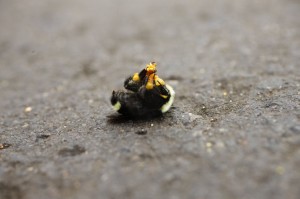Washington, DC–(ENEWSPF)–November 25, 2013. The Oregon Department of Agriculture (ODA) has restricted two pesticide products linked to massive bee die offs experienced in Oregon earlier this year. Both pesticides are neonicotinoid chemicals that are extremely harmful to bees. Though these restrictions are an important step in protecting bee health, the new rules will still not limit all of the uses of these chemicals that can harm pollinators.
ODA placed restrictions on dinotefuran and imidacloprid, banning their use on linden trees, basswood and other trees of the Tilia genus. Pesticide products that contain these active ingredients are now required to have Oregon-specific labels. This is only the second time in the past ten years that ODA has regulated pesticides more strictly than federal standards. These new restriction comes after ODA adopted a temporary rule in June that limited the use of 18 pesticide products that contained diontefuran. That rule was set to expire next month.
States and local jurisdictions have authority under the nation’s pesticide registration law, the Federal Insecticide, Fungicide and Rodenticide Act (FIFRA), to adopt more stringent pesticide use restrictions than the federal government. However, after the U.S. Congress rejected proposals to preempt local authority and the Supreme Court upheld the rights of localities in a 1991 decision, 43 states adopted some form of preemption of local authority. Seven states have clear authority without restriction, including the state of Maryland, where in July the City of Takoma Park adopted a ban on cosmetic lawn pesticides identified by the City Council as an unnecessary hazard to community residents and the environment. Local jurisdictions in 19 of the 43 states with preemption can appeal to their state government to adopt local restrictions; five of these have a clear process. Beyond Pesticides advocates that states and localities must have the authority, as in the case of protecting bees and beneficial organisms, to restrict pesticides when it is determined that federal restrictions do not meet state and local concerns about the health and environmental protections in place.
Dinotefuran and imidacloprid are both neonicotinoid pesticides that are highly toxic to bees. Neonicotinoids can be broadly applied as a spray, soil drench, or seed treatment, however, the ability of these chemicals to translocate through a plant as it grows has led to the creation of a large market within chemical-intensive landscaping and agriculture. Once these systemic pesticides are taken up by a plant’s vascular system, they are expressed through pollen, nectar and guttation droplets from which pollinators, such as bees, then forage and drink. Neonicotinoids kill sucking and chewing insects by disrupting their nervous systems.
This new regulation is a response to an incident earlier this year where an estimated 50,000 bumblebees, likely representing over 300 colonies, were found dead or dying in Wilsonville. According to the Xerces Society, this was the largest known incident of bumblebee deaths ever recorded in the country. After a preliminary investigation, ODA confirmed that the massive bee die-off was caused by the use of the insecticide dinotefuran. Then, it was reported by The Oregonian that hundreds of bees were found dead after the same pesticide was used in the neighboring town of Hillsboro. Dan Hilburn, director of plant programs at the Oregon Department of Agriculture (ODA), told Oregon Live that he had “never encountered anything quite like it in 30 years in the business.”
Regulators initially responded to this incident by prohibiting the use of dinotefuran on any plant. According to the temporary rule, “This includes, but is not limited to, applications on landscape trees and shrubs, nursery and greenhouse plants, turfgrass, forests and agricultural crops.” Products containing dinotefuran were taken off shelves and making an application of dinotefuran would result in the revocation of an applicator’s license. Before the new restrictions, these temporary rules were set to expire in December.
Though these new restrictions are an important step for state regulators trying to protect bees and other pollinators, these new regulations are extremely limited in their scope. Neonicotinoid pesticides used on plants that are attractive to that are not listed in the new restrictions can still be harmful to bees. These new regulations also does not regulate all forms of pesticide applications even to trees of the Tilia genus. These trees may have been planted using neonicotinoid treated seeds. A pilot study, co-authored by the Pesticide Research Institute, found that 7 of 13 samples of garden plants purchased at top retailers in Washington DC, the San Francisco Bay Area and Minneapolis contain neurotoxic pesticides known as neonicotinoids that studies show harm or kill bees and other pollinators.
Due to the absence of strong regulatory safeguards for pollinators, it is important for the public to become engaged in pollinator protection. Join Beyond Pesticides’ BEE Protective campaign and support a shift away from the use of these toxic chemicals by encouraging organic methods and sustainable land management practices in your home, campus, or community, and in food production.
Sources: Oregon Live, http://www.beyondpesticides.org
All unattributed positions and opinions in this piece are those of Beyond Pesticides.








